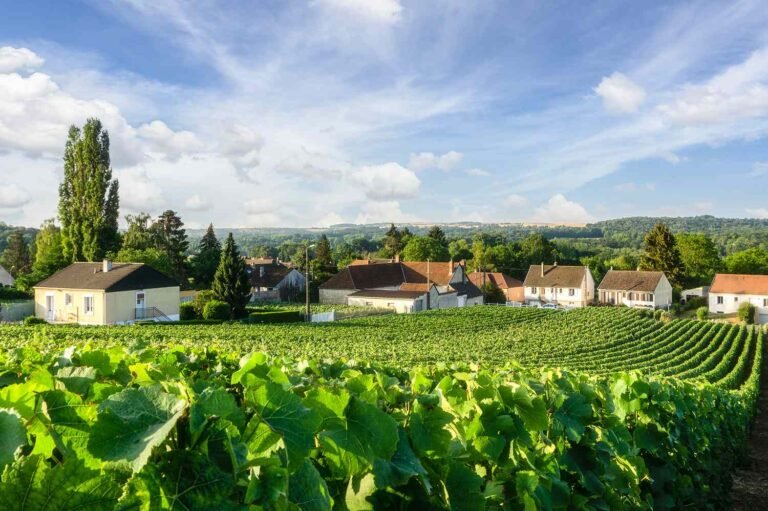- Reims, France, 45 minutes from Paris, is home to legendary Champagne houses, including the oldest in the world, Ruinart.
- The city also has other noteworthy landmarks such as a UNESCO-listed cathedral and Michelin-starred restaurants.
- Other nearby French towns include Hautvillers and Épernay, home to the iconic Avenue de Champagne.
Less than an hour from Paris by high-speed train, you’ll find one of France’s premier destinations for Champagne lovers, and it offers far more than just tastings—though those are reason enough to visit.
Often called the unofficial capital of the Champagne region, Reims, France, is home to some of the world’s most storied houses, with cool cellars stretching for miles beneath its charming cobblestone streets and Belle Époque façades.
Among the most iconic is Ruinart, considered to be the oldest Champagne house in the world. It’s been producing bubbly since 1729, and visitors can see their extensive operations themselves. “Their cellars, named ‘Crayères,’ are some of the most impressive of the region,” says Philippe Marques, head sommelier at Royal Champagne Hotel & Spa in nearby Champillon, France. “The tour is both immersive and artistic.”
For a more unconventional experience—which Marques describes as “great for those who like their Champagne with a twist of creativity”—look no further than Champagne Pommery. “The estate features modern art installations inside historic cellars and bold visual storytelling,” he says.
Above ground, Reims is every bit as compelling, starting with its soaring namesake cathedral, a UNESCO World Heritage Site and Gothic landmark where French kings were crowned for nearly a thousand years. The tradition dates back to the 9th century, adding a regal layer to the city’s rich history. “Don’t miss the Chagall-stained glass windows and the ethereal light in the late afternoon,” says Anaïs Collinet, Royal Champagne’s guest experience makers manager.
Beyond the city’s architectural splendor, Collinet recommends immersing yourself in local life. “Enjoy the bustle of the market with a coffee at Le Marché and explore Les Halles du Boulingrin (The Boulingrin Market Halls) on Saturday morning to discover local products from the Champagne region,” she says. “Take a stroll along the Rue de Mars and the Rue du Tambour to reach the pretty Place du Forum and the emblematic Place Royale.”
The streets of the historic center of Reims, France.
southtownboy/Getty Images
Reims is also a delight for gourmands—no surprise, given its location in the heart of the Champagne region. According to Collinet, must-try restaurants include Le Coq Rouge for wine and tapas; the newly opened Polychrome, a Champagne Taittinger-backed concept that spotlights sparkling pairings; Glue Pot, a French take on a classic British pub; and Le Boulingrin, a classic brasserie.
For those looking to splurge, make a beeline for the two-Michelin-starred Le Parc at Domaine Les Crayère in Reims proper, known for its elegant setting and refined takes on French classics. Also in the city, Arbane has earned a Michelin star for its inventive, terroir-driven tasting menus. Just outside the city limits, you’ll find Le Royal, the Michelin-starred fine-dining centerpiece of the aforementioned Royal Champagne Hotel & Spa, where vineyard views pair with a seasonal menu focused on local ingredients and Champagne-friendly flavors.
Champagne bottles sit in racks inside the Taittinger SA cellars in Reims, France.
Marlene Awaad/Getty Images
Getting there is easy, too. “The train from Gare de l’Est in Paris takes only 45 minutes to reach Reims’ main station, which is conveniently located right in the heart of the city,” says Collinet.
Once you arrive, she has two final tips: “Always book tastings and tours in advance, especially for the major Champagne houses.” Additionally, she recommends a day trip to the vineyards of Hautvillers, France, and Épernay, France, followed, of course, by a leisurely lunch on the terrace at Royal Champagne.
While in Épernay, carve out some time to stroll along the iconic Avenue de Champagne. Often called “Champagne Row,” this grand boulevard is lined with historic maisons like Moët & Chandon, Perrier-Jouët, and Pol Roger, many of which sit atop miles of chalk cellars carved into the hillside.
Finally, finish off the trip with a visit to the fairytale-worthy village of Hautvillers to see the Abbaye Saint-Pierre d’Hautvillers, where Dom Pérignon—yes, that Dom Pérignon—is buried. While the abbey itself isn’t open to the public, the adjoining church is, offering a glimpse into the life and legacy of the Benedictine monk who played a pivotal role in the development of this beloved libation.
